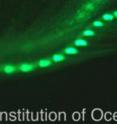Unusually large family of green fluorescent proteins discovered in marine creature
Related images
(click to enlarge)
Researchers at Scripps Institution of Oceanography at UC San Diego and the Salk Institute for Biological Studies have discovered a family of green fluorescent proteins (GFPs) in a primitive sea animal, along with new clues about the role of the proteins that has nothing to do with their famous glow. GFPs recently gained international attention with the awarding of the 2008 Nobel Prize in Chemistry, shared by UC San Diego's Roger Tsien, as word spread of their extensive presence in nature as well as benefit to researchers. GFPs, originally isolated from a luminous jellyfish, have gained scientific ubiquity in uses ranging from biomedical tracers to probes for testing environmental quality. But while the value of GFPs in biomedicine and bioengineering has become evident, their diversity across the tree of life and their role in nature haven't been as easily deciphered.
New hints have emerged as Erin Bomati, a former postdoctoral researcher at Scripps Oceanography, Gerard Manning of the Salk Institute for Biological Studies and Scripps lead-scientist Dimitri Deheyn discovered the largest known family of GFPs. They found 16 related types of GFPs in amphioxus, a thin, non-luminous fish-like animal that lives in coastal areas and spends most of its time burrowed in ocean sand. The discovery, described in the journal BioMed Central (BMC) Evolutionary Biology, was made in Branchiostoma floridae, an amphioxus species collected off Tampa, Fla.
Amphioxus, also known as lancelets, is the closest living invertebrate relative of vertebrates and much more evolved than the jellyfish in which the original GFP discovery was made. In the paper, the researchers demonstrate that the 16 newly discovered GFPs have different characteristics of light production, some brightly fluorescent and others less or not at all.
"Despite a huge knowledge base about the biochemistry of GFPs, little is know about their biological functions and our results clearly indicate that it is not always related to fluorescence," said Deheyn.
Using a range of genetic analyses and techniques, including sequencing and cloning, the researchers discovered that some GFPs, especially those with low fluorescence capacity, could have a defense function in the wild acting as an antioxidant, working to protect the animal in times of illness or stress. It's the first evidence of the proteins being used in a role beyond glowing fluorescence within the same organism.
"Originally GFPs might have been selected for their function of being able to absorb or re-emit light, but here we show that some GFPs can also act as antioxidants," said Deheyn. "This is the first time that we have identified distinct functions in coexisting GFPs."
Deheyn said GFPs appear to suppress so-called "oxygen radicals" from harmful effects to the amphioxus' body, similar to the role antioxidants serve in human bodies.
Deheyn said the new findings will help scientists understand the evolution of this protein across the animal kingdom, while providing bioengineers and biotechnologists a new window of comparison through the novel family of GFPs and an unveiled aspect of their application. The range of colors and functions encoded by these GFPs may also help to decode which aspects of their sequences are responsible for which functions and the engineering of new forms of GFP probes.
Source: University of California - San Diego
Other sources
- Unusually Large Family Of Green Fluorescent Proteins Discovered In Marine Creaturefrom Science DailySat, 23 May 2009, 3:49:46 UTC
- Unusually Large Family Of Green Fluorescent Proteins Discovered In Marine Creaturefrom Science DailyFri, 22 May 2009, 13:28:52 UTC
- Unusually Large Family of Green Fluorescent Proteins Discovered in Marine Creaturefrom Newswise - ScinewsThu, 21 May 2009, 2:42:17 UTC
- Unusually large family of green fluorescent proteins discovered in marine creaturefrom PhysorgWed, 20 May 2009, 20:21:13 UTC
- Unusually large family of green fluorescent proteins discovered in marine creaturefrom Science BlogWed, 20 May 2009, 19:49:15 UTC


